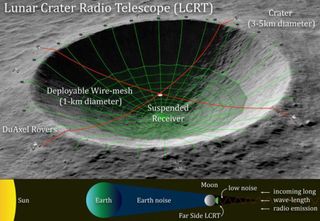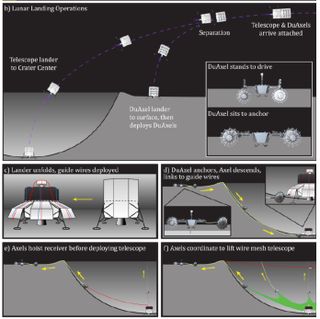NASA funds proposal to build a telescope on the far side of the moon

NASA is funding an early-stage proposal to build a meshed telescope inside a crater on the far side of the moon, according to Vice.
This "dark side" is the face of the moon that is permanently positioned away from Earth, and as such it offers a rare view of the dark cosmos, unhindered by radio interference from humans and our by our planet's thick atmosphere.
The ultra-long-wavelength radio telescope, would be called the "Lunar Crater Radio Telescope" and would have "tremendous" advantages compared to telescopes on our planet, the idea's founder Saptarshi Bandyopadhyay, a robotics technologist at NASA's Jet Propulsion Laboratory wrote in a proposal.
Related: 10 interesting places in the solar system we'd like to visit
NASA's Innovative Advanced Concepts Program is awarding $125,000 for a Phase 1 study to understand the feasibility of such a telescope, Bandyopadhyay told Vice.
The telescope — designed as a wire mesh — would be deployed into a 2- to 3-mile-wide (3 to 5 kilometers) crater on the moon's far side. The 0.62-mile-diameter (1 km) wire-mesh telescope would be stretched across the crater by NASA's DuAxel Rovers, or wall-climbing robots, according to the proposal summary.
If built, the "Lunar Crater Radio Telescope" would be the largest filled-aperture radio telescope in the solar system, Bandyopadhyay wrote. A filled-aperture radio telescope is a telescope that uses a single dish to collect data rather than many dishes, according to Vice.
Get the Space.com Newsletter
Breaking space news, the latest updates on rocket launches, skywatching events and more!
Because this telescope would be on the far side of the moon, it would avoid radio interference from Earth, satellites and even the sun's radio-noise during the lunar night. It would also let us gaze out into the cosmos without the veil of Earth's atmosphere.
The atmosphere reflects low-frequency wavelengths of light greater than 32.8 feet (10 meters), essentially blocking them from reaching ground-based telescopes. The telescope "could enable tremendous scientific discoveries in the field of cosmology by observing the early universe in the 10– 50m wavelength band...which has not been explored by humans till-date," Bandyopadhyay wrote.
Editor's Note: This story was updated on April 14 at 1:50 pm to clarify a statement about the radio-noise from the sun.

- 7 Everyday Things That Happen Strangely in Space
- Interstellar Space Travel: 7 Futuristic Spacecraft to Explore the Cosmos
- Photos: The 8 Coldest Places on Earth
Originally published on Live Science.
<a href="https://www.livescience.com/download-your-favorite-magazines.html" data-link-merchant="livescience.com"" target="_blank">OFFER: Save 45% on 'How It Works' 'All About Space' and 'All About History'!
For a limited time, you can take out a digital subscription to any of <a href="https://www.livescience.com/download-your-favorite-magazines.html" data-link-merchant="livescience.com"" data-link-merchant="livescience.com"" target="_blank">our best-selling science magazines for just $2.38 per month, or 45% off the standard price for the first three months.
Join our Space Forums to keep talking space on the latest missions, night sky and more! And if you have a news tip, correction or comment, let us know at: community@space.com.
-
Henderrj The inefficiency of driving up and down a craterside to drag wires seems too much. Would it not be better to use a simple projectile launch? Something like at 22 caliber bullet? Something spring powered? With the extremely light gravity it would seem that this would produce the desired effect much more quickly and probably at a lower weight.Then the rovers at top would simply grab each wire and attach it. This ideamight require pull wires which woud then reel up the telescope wires, but even that might save quite a bit of weight over the initially proposed solution.Reply -
Homer10 I worked for the SETI Institute, and Ames Research Center NASA from 1992 to 1998. I remember they were talking about a facility on the dark side of the Moon back in 1995. It was one of those very much future proposals. You know, the way things are now going, this might not be such a far out concept. The crater approach might be accomplished with robots. The potential performance could be amazing. Not just for SETI, but all manner of Radio Astronomy. This could be a very interesting project.Reply -
Lovethrust Reminds me of building a spiders web. The science return from this would be truly jaw dropping.Reply -
bolide What happens during the phase of the moon (new moon) when the far side is directly facing the sun?Reply -
Synthmind To transmit the signal back to Earth they will need to have a functioning lunar satellite array, a land based radio relay to the earth side, or ground lay fiber to the earth side to transmit. On the dark side solar energy would not help so a small reactor? Lots more involved than placing and sagging suspension strands.Reply



